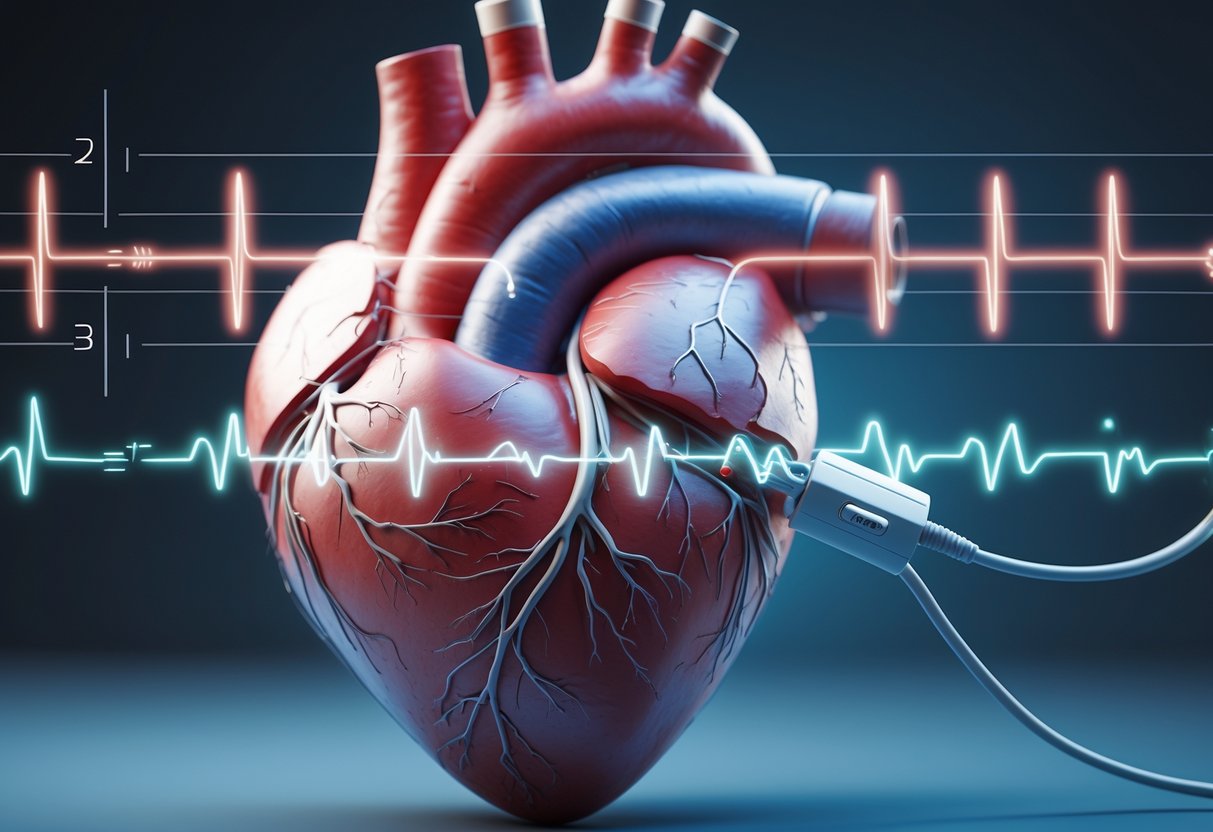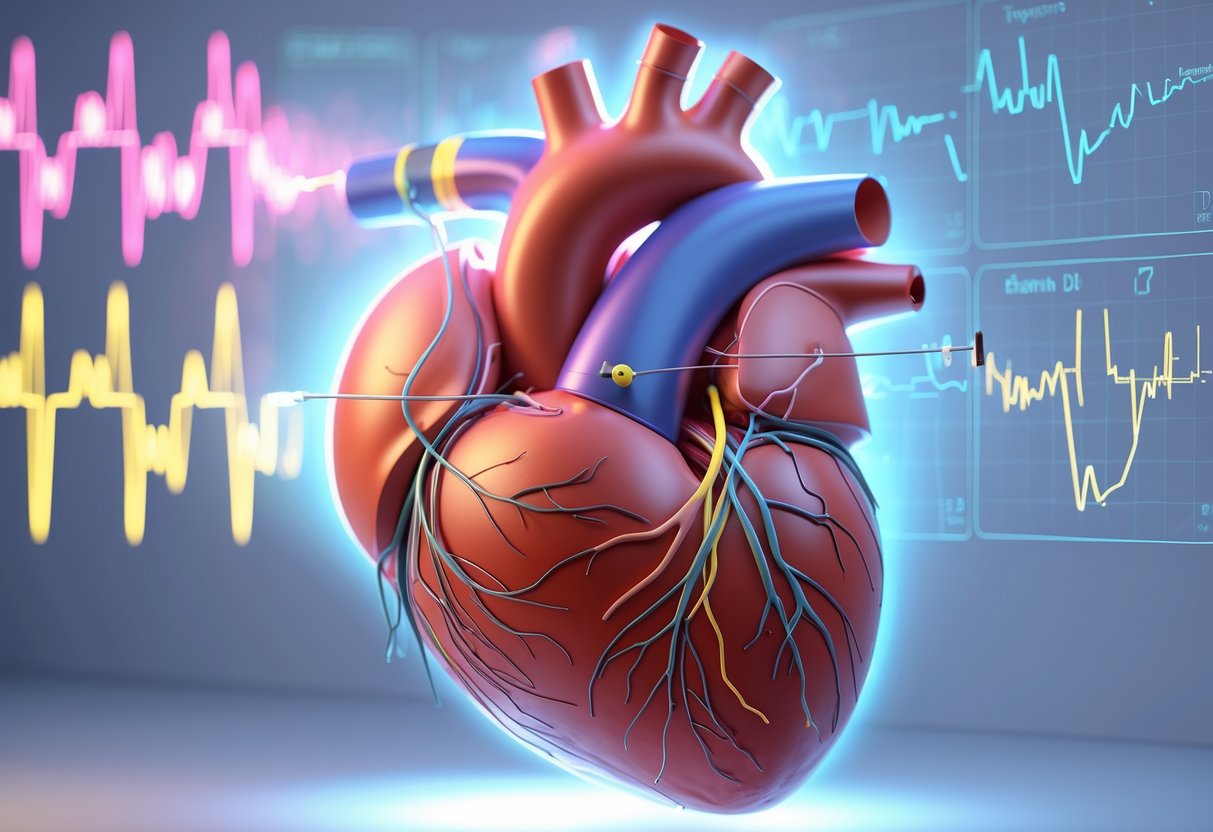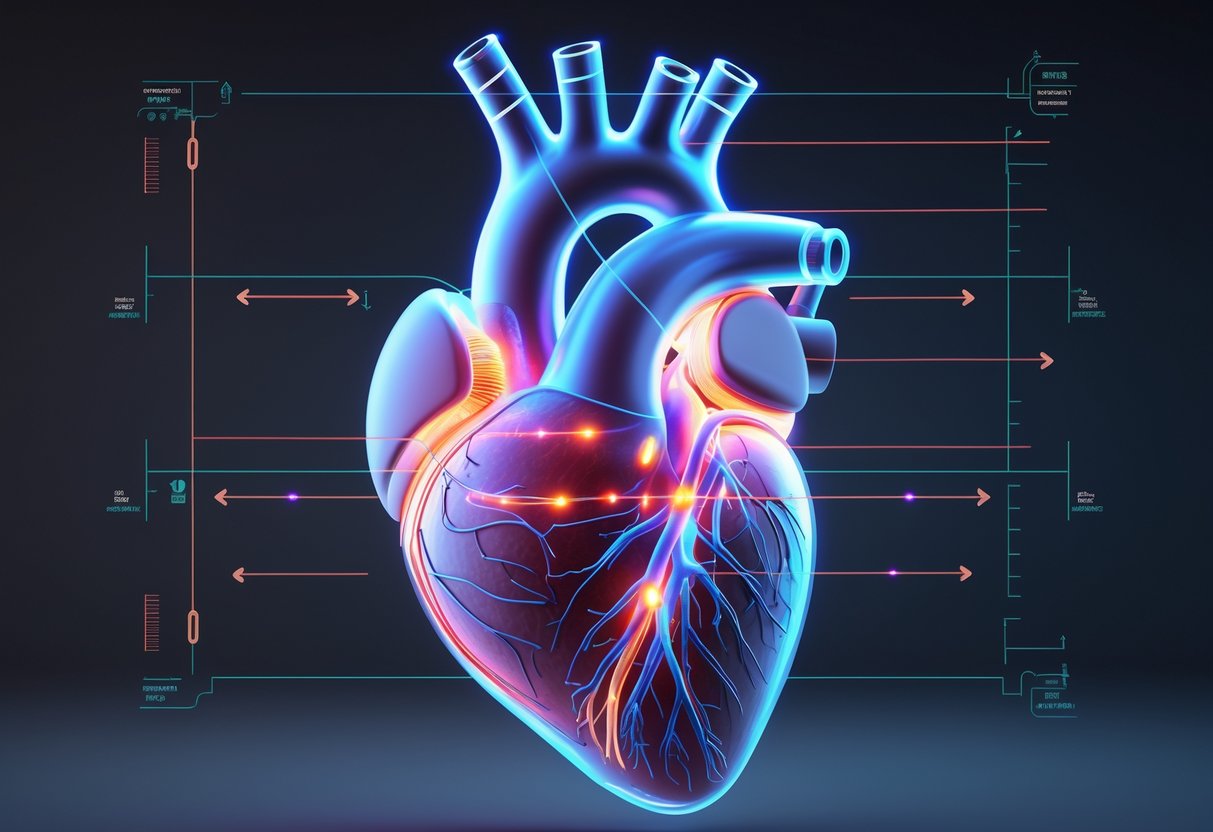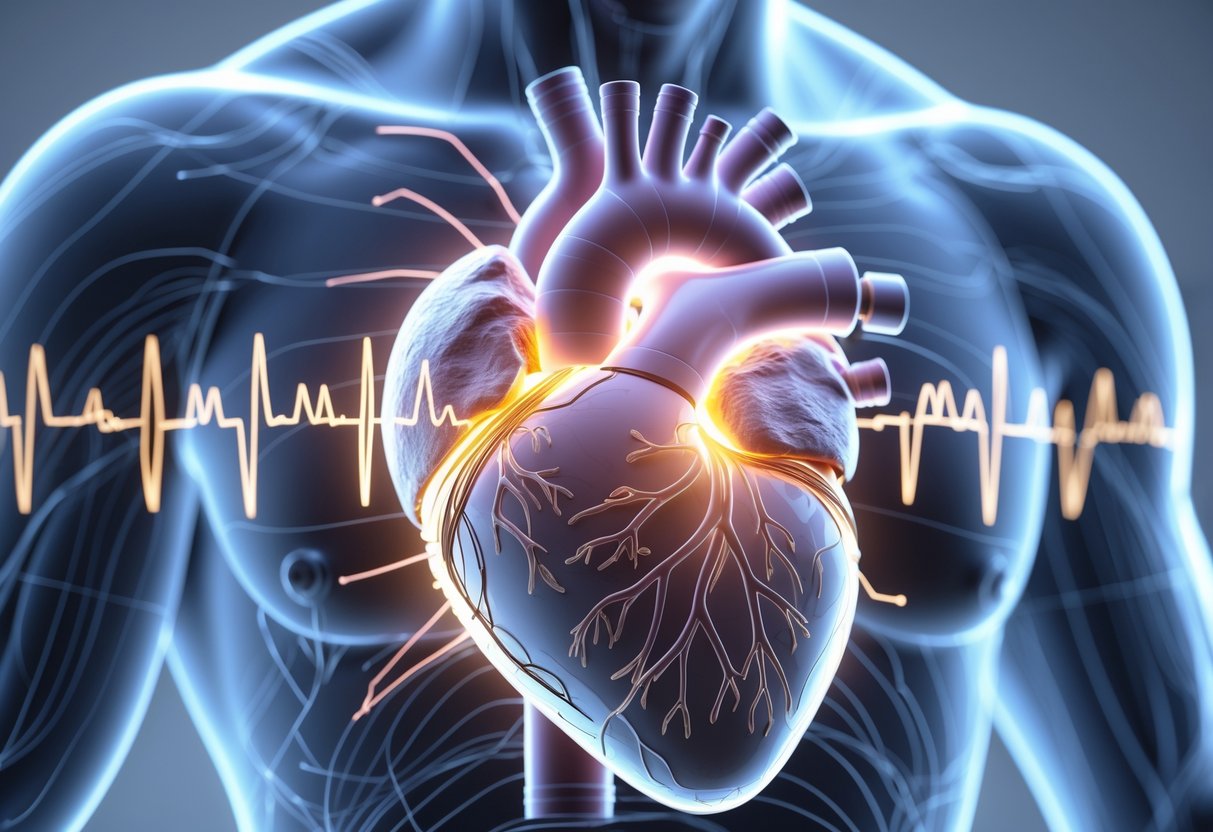Segment Pacing: Identifying Acute Myocardial Infarction in Paced Rhythm
Updated On: November 13, 2025 by Aaron Connolly
Core Concepts of Segment Pacing

Segment pacing tracks how fast electrical signals travel through different parts of your heart during an ECG. The ST-segment part highlights changes that help doctors catch heart attacks fast.
Definition and Importance
Segment pacing is basically the timing between heart muscle contractions. We spot this most clearly in the ST-segment on an ECG.
The ST-segment sits between the QRS complex and the T wave. Usually, this section looks flat or has a gentle curve. If the heart muscle isn’t getting enough blood, the segment changes shape almost instantly.
Normal ST-segment characteristics:
- Duration: 80-120 milliseconds
- Shape: Flat or with a slight upward curve
- Position: At or near the baseline
Segment pacing shifts within minutes during a heart attack. Damaged areas either slow down or speed up the electrical signals, and this creates those patterns doctors rely on.
Catching these segment changes quickly can literally save lives. Every minute matters when heart muscle starts dying.
Clinical Relevance of ST-Segment Changes
ST-segment elevation shows up as an upward spike on the ECG. That’s usually a sign of a major heart attack happening right now—what we call STEMI.
Doctors need to treat STEMI within 90 minutes. The elevated segment tells us there’s a totally blocked coronary artery.
ST-segment depression dips below the baseline. This means the heart muscle isn’t getting enough blood, but the artery isn’t fully blocked.
| ST-Change Type | What It Means | Treatment Urgency |
|---|---|---|
| Elevation >1mm | Major heart attack (STEMI) | Emergency (90 minutes) |
| Depression >0.5mm | Partial blockage | Urgent (hours) |
| No change | Normal or other cause | Standard assessment |
Different ST patterns show which part of the heart is in trouble. Front wall issues show up in leads V1-V4. Bottom wall problems turn up in leads II, III, and aVF.
How fast the segment changes also matters. If you see rapid elevation in just a few minutes, a severe blockage is probably forming.
Challenges in Identifying Myocardial Infarction
A bunch of conditions can mimic heart attack patterns on ECGs. Pericarditis causes widespread ST-elevation that looks a lot like AMI.
Age changes normal segment patterns. Older folks often have baseline differences that make new issues harder to spot.
Common mimics of heart attack patterns:
- Chest muscle strain
- Lung blood clots
- Inflammation around the heart
- Medication effects
- Previous heart damage
Poor electrode placement can mess up the readings. Things like chest hair, sweat, or movement throw off the segment’s appearance.
Some heart attacks don’t give classic ST-changes. These are called NSTEMI (non-ST-elevation myocardial infarction). In those cases, blood tests matter more than the ECG.
Women and people with diabetes often have subtle segment changes. Their symptoms don’t always match the textbook.
Even experienced doctors can struggle with borderline cases, despite training. Computer analysis sometimes catches patterns that human eyes miss.
Pacemaker Rhythms and ECG Patterns
Paced rhythms stand out on ECGs. They look different from natural heartbeats. The wide QRS complexes and their specific shapes tell us when a pacemaker is running the show.
Ventricular Paced Rhythm Characteristics
Ventricular paced rhythms have some unmistakable features. You’ll spot a pacing spike just before each QRS complex—a sharp, vertical line that lasts about 2 milliseconds.
The QRS complexes are always wide, usually over 120 milliseconds. That’s because the impulse spreads through the muscle, not the normal conduction system.
When the pacemaker is in charge, the rhythm stays regular. The rate depends on how the device is set, but most are between 60-70 beats per minute.
Sometimes, fusion beats pop up. That’s when both natural and paced impulses hit the ventricles at once. The QRS looks a bit narrower in those cases.
ECG Appearance of Paced Beats
Pacing spikes change size depending on the lead system. Unipolar leads make bigger spikes than bipolar ones. In some ECG leads, you might barely see the spike at all.
QRS morphology shifts with lead placement. Right ventricular pacing usually creates a left bundle branch block look. You’ll see a mostly negative QRS in lead V1 and positive ones in leads I and V6.
ST segments and T waves should be discordant with the QRS. That just means they point in the opposite direction.
If the pacemaker’s working right, each paced beat should look the same. If you see pacing spikes with no QRS afterward, that’s loss of capture.
Distinction from Left Bundle Branch Block
Both ventricular pacing and LBBB give you wide QRS complexes with similar shapes. But a few things help us tell them apart.
Pacing spikes are the giveaway. You’ll always see them before a paced QRS, but never in natural LBBB.
Paced QRS complexes are often wider than those from LBBB. Sometimes they measure 140-160 milliseconds or even more.
Paced rhythms keep the same look from beat to beat. Natural LBBB can change QRS shape a bit, especially if the rate changes.
The patient’s history helps too. If someone has a pacemaker, it’s documented. LBBB usually shows up because of heart disease.
Understanding the QRS Complex in Paced Rhythms
The QRS complex in ventricular pacing looks wide and abnormal compared to normal heartbeats. This creates a left bundle branch block pattern, which makes ECGs tricky in paced patients.
Morphology of QRS Complex
On an ECG, ventricular pacing makes the QRS complex look really different. The pacing spike comes first, then a wide QRS follows.
Key features:
- QRS duration over 120 milliseconds
- Pacing spike right before the QRS
- Changed ST segments and T waves
The QRS shape depends on where the pacing lead is. Right ventricular leads and left ventricular leads give different patterns.
Pacing lead positions change appearance:
- Right ventricle pacing = LBBB-like pattern
- Left epicardial pacing = RBBB-like pattern
You’ll see discordant ST segments and T waves pretty often. The T wave points the opposite way from the QRS.
Implications of Wide QRS Complex
A wide QRS in paced rhythms makes ECG interpretation tough. We can’t just use the usual criteria for heart attacks or other issues.
Clinical impacts:
- Hides signs of myocardial infarction
- Changes normal voltage readings
- Messes with rhythm analysis
Atrial pacing doesn’t change the QRS. The ventricles still use the normal pathway, so QRS stays narrow.
Ventricular pacing always gives you wide complexes. That’s because the signal spreads slowly through heart muscle instead of the fast system.
We need to adjust how we read ECGs in paced patients. The regular rules for wide QRS complexes don’t quite fit.
LBBB Morphology and Its Impact
Right ventricular pacing creates a left bundle branch block pattern on ECG. This LBBB look is pretty standard in most ventricular paced rhythms.
LBBB characteristics in pacing:
- Wide QRS in leads V5 and V6
- Deep S waves in leads V1 and V2
- Notched or broad R waves in lateral leads
The LBBB pattern makes it tough to spot heart attacks. We can’t use the normal ST elevation rules here.
Detection challenges:
- ST changes might just be from pacing
- T wave inversions are expected
- Q waves don’t really help
We use special criteria like Sgarbossa rules to find heart attacks in LBBB patterns. These tweaks help us get around the changes caused by pacing.
Knowing the LBBB look helps us tell normal paced beats from real trouble.
ST-Segment Changes and Myocardial Infarction Diagnosis

When a pacemaker is in use, spotting a heart attack gets a lot harder. The pacemaker changes how the heart’s electrical signals show up on the ECG. Still, certain ST-segment patterns can break through the noise and reveal when heart muscle is dying.
Concordant ST-Segment Elevation
Concordant ST-elevation means the ST-segment moves in the same direction as the main QRS. This is the most trustworthy sign of a heart attack during pacing.
Key Features:
- ST-elevation ≥1mm in leads with positive QRS complexes
- ST-elevation ≥5mm in leads with negative QRS complexes
- Most common in left bundle branch block patterns
We treat this as the gold standard because it’s very specific for acute MI. Measure the elevation from the end of the QRS (the J-point).
If you spot concordant ST-elevation, you’re probably looking at a blocked major heart artery. The pacemaker can’t really hide this kind of injury.
Usually, this single finding is enough to diagnose STEMI. There’s no need to wait for blood tests or extra proof.
Discordant ST-Segment Elevation
Discordant ST-elevation happens when ST-segments move in the opposite direction from the QRS. It’s harder to read but still useful.
The ST/S Ratio Rule:
- Measure ST-elevation in leads with negative QRS
- Divide by the depth of the S-wave
- Ratio ≥0.25 points to acute MI
We use this ratio because discordant elevation can show up normally with pacing. The math helps us pick out what’s abnormal.
Clinical Application:
- Best in leads V1-V3
- Less reliable than concordant changes
- Needs careful measuring
This pattern might show up before concordant changes. Sometimes we catch heart attacks earlier with this, especially with smaller blockages.
Recognising ST-Segment Depression
ST-depression in paced rhythms can point to heart attacks in spots not directly seen on standard ECG leads. We look for depression that’s deeper than pacing alone would cause.
Significant Depression Criteria:
- ≥1mm in leads V1-V3 (concordant depression)
- New depression compared to old ECGs
- Depression in several lead groups
Concordant ST-depression in V1-V3 often means blockage of the left circumflex artery. That’s a “posterior STEMI” and it’s easy to miss.
We also watch for discordant depression that’s too deep. Using the same ratio rules as for elevation, deep depression can show heart muscle damage.
Practice Points:
- Compare to old ECGs if you have them
- Look for reciprocal changes
- Try posterior leads (V7-V9) if you can
If you see these depression patterns along with symptoms, acute coronary occlusion is likely—even if there’s no obvious ST-elevation.
Sgarbossa Criteria for Diagnosing STEMI

The Sgarbossa criteria give doctors a way to spot heart attacks in patients with pacemakers or tricky heart rhythms. These special rules look for different ECG changes than the usual heart attack signs because pacing covers up the classic patterns.
Historical Overview of Sgarbossa Criteria
Back in 1996, Dr. Elena Sgarbossa came up with these criteria to solve a stubborn problem. Doctors just couldn’t reliably diagnose heart attacks in patients with left bundle branch block or ventricular pacing.
The original rules had three points and a scoring system. If you scored 3 or more, you’d call it a heart attack. It was 90% accurate when positive, but it missed a lot of cases.
Later, the Smith-modified version improved things. It changed the third rule to use proportional measurements—comparing ST elevation to the S wave’s size.
This update made the criteria more sensitive. It picked up heart attacks the old version missed. Now, a lot of hospitals use these modified rules.
Key Sgarbossa Criteria in Paced Rhythm
These criteria highlight three main ECG changes during ventricular pacing.
Concordant ST elevation of 1mm or more shows up in leads with positive QRS complexes. Here, both the ST segment and QRS point in the same direction.
Concordant ST depression of 1mm or more appears in leads V1, V2, or V3. The ST segment drops down when the QRS is also negative.
Proportional discordant ST elevation means the ST rise is at least 25% of the depth of the preceding S wave. This replaced the old 5mm rule.
Ventricular pacing creates an artificial left bundle branch block pattern. That basically makes normal STEMI criteria useless.
The Sgarbossa rules work around this electrical interference.
Interpreting ECGs gets trickier with pacing. Normally, “appropriate discordance” means ST segments naturally oppose the QRS direction.
The criteria help spot when this discordance gets excessive.
Strengths and Limitations
Sgarbossa criteria do a great job confirming acute myocardial infarction when it’s actually there. They hit about 90% specificity, so you don’t get many false positives.
These rules work for patients with pacemakers and those with natural left bundle branch blocks. The clear numerical cutoffs really cut down on guesswork.
Heads up: The original criteria miss a lot of heart attacks because their sensitivity is low. Even the modified version only catches about half of all cases.
You need pretty careful ECG measurement skills to use these criteria. Doctors have to measure ST segments and S wave depths accurately.
Small mistakes here can change the diagnosis.
Time pressure in emergencies makes things even harder. Staff need good training to use these criteria properly.
Missing these signs could delay life-saving treatment and, in the worst case, lead to cardiogenic shock.
Some patients have baseline ECG changes that make things even more confusing. Previous heart attacks or certain medications can mess with the measurements.
Smith-Modified Sgarbossa Criteria and Advances
The Smith-modified Sgarbossa criteria improved heart attack diagnosis by ditching the rigid 5mm rule. Now, it uses a flexible ST/S ratio of ≥0.25.
This proportional approach catches more heart attacks and still keeps false positives low.
The Smith-Modified Sgarbossa Criteria Explained
Dr. Stephen Smith and his team developed the Smith-modified Sgarbossa criteria to fix the original criteria’s weak sensitivity. The old rules caught 90% of cases correctly, but only found 49% of real heart attacks.
The modification kept two original rules:
- Concordant ST-segment elevation ≥1mm in leads with positive QRS
- Concordant ST-segment depression ≥1mm in leads V1-V3
The big change landed on the third rule. Instead of needing discordant ST-segment elevation ≥5mm, the new approach uses proportional measurement.
Switching from absolute values to ratios makes the criteria more responsive to individual differences. Heart electrical patterns just aren’t the same for everyone.
How the ST/S Ratio Improves Sensitivity
The ST/S ratio compares ST elevation to the depth of the S wave in the same lead. When this ratio hits 0.25 or higher, it points toward a heart attack, not just normal paced changes.
This proportional method works because it considers different S wave depths. For example, a patient with a deep 20mm S wave needs 5mm ST elevation to meet criteria. Someone with a shallow 8mm S wave only needs 2mm elevation.
The ratio bumps up sensitivity but keeps specificity high. Studies show the modified Sgarbossa criteria spot more heart attacks without flagging too many false alarms.
To get the ratio, divide ST elevation by S wave depth in millimetres. If the result is at least 0.25, the criterion is met.
Comparing Classic and Smith-Modified Approaches
| Criterion | Original Sgarbossa | Smith-Modified |
|---|---|---|
| Concordant ST elevation | ≥1mm in positive QRS leads | ≥1mm in positive QRS leads |
| Concordant ST depression | ≥1mm in V1-V3 | ≥1mm in V1-V3 |
| Discordant ST elevation | ≥5mm absolute | ST/S ratio ≥0.25 |
| Sensitivity | 49% | Significantly improved |
| Specificity | 90% | Maintained at 90% |
The original criteria used a point system with weighted scores. The Smith-modified version makes it simpler—if any single criterion meets the threshold, you call it a heart attack.
This change helps in emergencies. Nobody wants to do complex math when the clock’s ticking.
The modified approach fits better with how heart electrical activity actually changes during attacks. Proportional changes matter more than just the absolute numbers in paced hearts.
Interpretation Challenges in Segment Pacing

Reading ECGs during segment pacing brings unique challenges that can trip up even experienced clinicians.
The altered electrical patterns tend to mask normal cardiac rhythms and throw off signals that look like something serious.
Mimics and Pitfalls
ST elevation patterns during ventricular pacing often look exactly like heart attacks on ECG. Paced beats create secondary changes in the ST segment and T wave.
These changes show up as ST elevation in leads with negative QRS complexes. That’s the same thing you see during real coronary blockages.
A lot of doctors mistake these normal pacing changes for emergencies. The key is realising that ventricular pacing naturally causes these ST changes.
Right ventricular pacing from the apex is especially confusing. Most ECG leads will show negative QRS complexes, then ST elevation and positive T waves.
Atrial pacing doesn’t mess with QRS or ST segments. That makes it easier to spot real heart problems when only the atria are paced.
Wide QRS complexes during ventricular pacing hide the usual electrical patterns we rely on for diagnosing heart attacks. Paced rhythm overrides the heart’s natural signals.
Fusion and Pseudofusion Beats
Fusion beats pop up when the heart’s natural rhythm tries to compete with the pacemaker. The resulting QRS complex blends both electrical signals.
These beats show intermediate morphologies between fully paced and natural beats. The shape depends on which signal wins out.
Pseudofusion beats happen when pacing spikes show up during natural QRS complexes. The pacemaker fires, but doesn’t actually capture the heart muscle.
You have to look closely at timing to tell fusion from pseudofusion. True fusion changes the QRS shape compared to purely natural beats.
Programming issues can make fusion beats more common. That just makes ECG interpretation even tougher during routine checks.
Fusion beats usually mean the pacemaker’s working right, not failing. They show the device responds to the heart’s own activity.
ECG Interpretation Errors
QRS duration measurements get unreliable during pacing. Artificial stimulation changes the timing between heart chambers.
Automated ECG systems often misread paced rhythms. Computers flag normal pacing patterns as abnormal.
Lead placement changes how pacing artifacts show up on ECG. Bad electrode placement makes it tough to spot pacing spikes and capture.
Timing cycles between atrial and ventricular pacing can confuse rhythm analysis. Normal AV delays might look like conduction blocks.
Capture assessment means comparing paced and unpaced beats in the same patient. One ECG snapshot usually isn’t enough.
Rate-dependent changes in paced QRS morphology make sequential ECG comparisons tricky. The same pacemaker settings can create different-looking rhythms.
Clinical Implications and Emergency Management
Segment pacing complications need quick recognition and immediate intervention to prevent life-threatening outcomes.
Emergency teams have to act fast, starting heart failure protocols and watching for sudden cardiac arrest risks.
Prompt Recognition in Emergency Medicine
Emergency physicians must spot segment pacing malfunctions quickly by watching for ECG changes and clinical symptoms. Patients usually show up with chest pain, shortness of breath, or sudden weakness.
Watch for abnormal QRS patterns and loss of electrical capture. The ST segment may elevate if pacing wires touch the heart wall the wrong way.
Critical assessment steps:
- Check pacing thresholds right away
- Confirm lead placement with imaging
- Watch for arrhythmias
- Assess haemodynamic stability
Doctors often need to place a transvenous pacemaker if external pacing fails. Emergency teams should get ready for immediate action, especially with complete heart block or severe bradycardia.
Time is everything—delays can lead to cardiac arrest or cardiogenic shock.
Calls for Heart Failure Pathways
Segment pacing complications can trigger acute heart failure episodes that need immediate protocol activation. Patients develop fast fluid retention and lower cardiac output within hours.
Emergency teams should start diuretics and keep a close eye on fluid balance. Hypertension often comes along for the ride, so blood pressure management is key.
Heart failure indicators:
- Pulmonary oedema
- Elevated jugular venous pressure
- Peripheral swelling
- Reduced exercise tolerance
The risk of acute myocardial infarction goes up during pacing malfunctions. The heart muscle might get damaged from poor perfusion or electrical issues.
Immediate echocardiography helps check ventricular function. Early use of heart failure meds can keep things from spiraling into cardiogenic shock.
Risks for Cardiac Arrest
Segment pacing failures set up high-risk situations for sudden cardiac arrest. Patients might have complete electrical failure or dangerous arrhythmias without warning.
Ventricular fibrillation becomes more likely if pacing leads go wrong. Emergency teams should keep defibrillation gear close by and be ready for immediate resuscitation.
Arrest risk factors:
- Lead displacement
- Battery depletion
- Infection at insertion site
- Electrolyte imbalances
Continuous cardiac monitoring is a must for all segment pacing patients. Crash trolleys should stay nearby, and advanced life support needs to be ready.
Training staff on pacemaker troubleshooting can head off a lot of arrest situations. Quick recognition and correction of pacing problems often stop things from getting worse.
Role of Pacemakers and Pacing Strategies

Modern pacemakers give us a lot of pacing options for different heart rhythm problems.
Choosing between single-chamber ventricular pacing and advanced biventricular systems depends on the patient’s specific issue and their risk for heart failure.
Pacemaker Types and Indications
Pacemakers treat bradyarrhythmias by sending electrical signals to keep the heart rate up. Single-chamber pacemakers pace either the atrium or ventricle, while dual-chamber devices coordinate both.
Common pacemaker indications:
- Sinus node dysfunction
- Atrioventricular (AV) block
- Heart failure with conduction delays
Right ventricular pacing was the standard for years. Unfortunately, it can cause heart failure in 6-39% of patients because it throws off heart muscle coordination.
Modern devices use smarter algorithms to avoid unnecessary ventricular pacing. This cuts down on pacing-related complications but still keeps the heart beating safely.
Newer pacemaker technologies:
- Leadless pacemakers (no wires through blood vessels)
- Conduction system pacing (stimulates natural electrical pathways)
- Rate-responsive pacing (adjusts to activity levels)
Ventricular Pacing vs. Biventricular Pacing
Standard ventricular pacing stimulates the right ventricle, creating an abnormal pattern like left bundle branch block. That causes the heart chambers to contract out of sync.
The DAVID trial found that too much right ventricular pacing raises mortality and heart failure hospitalisations. One-year survival was 84% with minimal pacing compared to 73% with standard dual-chamber pacing.
Biventricular pacing solves this by stimulating both ventricles at the same time. This setup needs leads in the right and left ventricle (usually through coronary sinus branches).
Key differences:
| Pacing Type | Leads Required | Synchronisation | Heart Failure Risk |
|---|---|---|---|
| Right ventricular | 1-2 | Poor | Higher |
| Biventricular | 3 | Good | Lower |
His bundle pacing and left bundle branch area pacing are newer alternatives. These techniques stimulate the heart’s natural conduction system instead of the muscle tissue directly.
Cardiac Resynchronisation Therapy
Cardiac resynchronisation therapy (CRT) uses biventricular pacing to help heart failure patients who have electrical conduction delays. By coordinating the ventricles, CRT boosts the heart’s pumping efficiency.
CRT really shines for patients with heart failure, reduced ejection fraction (≤35%), and wide QRS complexes (≥150ms) that signal electrical delay. Right now, guidelines strongly recommend this combination.
Major CRT trials found:
- Better exercise capacity (6-minute walk test)
- Higher quality of life scores
- Fewer heart failure hospitalisations
- Lower mortality rates
The COMPANION and CARE-HF trials made CRT the standard for certain heart failure patients. These studies showed that CRT slashed deaths and hospitalisations compared to medication alone.
Roughly 30% of patients don’t respond to CRT, often because of heavy heart muscle scarring. In these cases, conduction system pacing might help by creating more natural activation patterns.
Modern CRT devices offer multipolar leads with different pacing setups. This flexibility helps avoid unwanted muscle stimulation and lets doctors tweak things for each patient.
Correlation with Patient Outcomes

Patient outcomes with segment pacing really depend on the underlying problem and how soon doctors intervene. ST-elevation myocardial infarction (STEMI) patients show unique patterns that shape both short-term survival and long-term outlook.
Prognosis in Paced STEMI
Patients who need pacing during acute STEMI face much higher mortality than those with normal conduction. Where the infarct happens matters a lot for prognosis.
Inferior STEMI with pacing usually leads to better outcomes. These folks often develop a temporary AV block that clears up in 48-72 hours. If pacing supports them through this window, over 80% recover.
Anterior STEMI needing pacing is a different story. The amount of muscle damage needed to cause conduction problems points to a bigger infarct. Hospital mortality can hit 30-40% here.
Three big prognostic factors stand out:
- Timing of block onset: If the block happens early (within 6 hours), it usually means acute ischaemia, not permanent damage.
- Degree of block: Complete heart block needs immediate action.
- Response to treatment: If conduction comes back within 72 hours, long-term survival looks much better.
Reperfusion Therapy Considerations
Segment pacing can really shape how we handle reperfusion in acute myocardial infarction. When conduction issues show up, it often means there’s more widespread coronary disease and aggressive intervention is needed.
Primary PCI timing becomes a race against the clock if pacing is required. We push for fast catheterisation because restoring blood flow may reverse the conduction block. Studies found that successful reperfusion within 90 minutes brings back normal conduction in 60% of cases with temporary blocks.
Thrombolytic therapy tends to work less well for patients who need pacing. The level of tissue damage hinted at by conduction problems limits what clot-busting drugs can do.
Pacing keeps the blood pressure up during reperfusion, preventing cardiogenic shock while doctors work to clear the blockage. This bridge support bumps up procedural success and cuts down on complications during emergency catheterisation.
Special Considerations in ECG Interpretation

Heart rate changes and existing heart conditions can really mess with how we read paced ECGs. You have to pay close attention or you might miss something important.
Effect of Heart Rate Fluctuations
Heart rate swings can make ECGs tricky in paced patients. When the natural heart rate drops below the pacemaker’s base rate, you’ll see clear pacing spikes followed by QRS complexes.
Rate-dependent changes show up during exercise or stress. At higher heart rates, the QRS complex can look wider because the heart’s conduction slows down.
Watch out for fusion beats if the patient’s own rate gets close to the pacemaker’s setting. These happen when both the heart and pacemaker fire at once, creating a weird-looking QRS.
Key things to watch:
- Base rate is usually set at 60 beats per minute.
- Heart rates under 50 per minute usually mean the pacemaker isn’t firing.
- Sudden rate changes might point to pacemaker trouble.
During Holter monitoring, we often spot rate variability that reveals how the pacemaker behaves. This helps us sort out normal pacing from possible device problems.
Impact of Underlying Cardiac Conditions
Pre-existing heart problems can really complicate ECG reading in paced patients. Hypertension can cause left ventricular hypertrophy, which already changes the QRS complex before pacing even comes into play.
Ventricular pacing creates wide QRS complexes that look like left bundle branch block. This makes it tough to spot acute myocardial infarction since the abnormal depolarisation hides typical ST-segment shifts.
Cardiac memory adds another layer. ST-T wave changes from earlier pacing episodes can stick around even if the pacemaker isn’t active.
Common masking effects:
- Ischaemic changes hidden by the paced QRS
- Pre-existing blocks making interpretation harder
- Cardiomyopathy changing how pacing looks
We suggest comparing new ECGs to older ones to spot fresh changes. The Sgarbossa criteria can help flag acute coronary events, though they’re not fully validated for paced rhythms yet.
Atrial pacing keeps the QRS normal, so it’s easier to spot ischaemia compared to ventricular pacing.
Future Directions and Research

New diagnostic tools and advanced ECG tech are shaking up how we spot segment pacing patterns. Researchers are busy refining criteria to help doctors catch these changes faster and more accurately.
Emerging Diagnostic Criteria
Right now, research is all about improving how we diagnose segment pacing effects on ECGs. The modified Sgarbossa criteria and Smith-modified Sgarbossa criteria look promising for picking up heart attack patterns in paced rhythms.
These new criteria help doctors separate normal pacing changes from real trouble. Traditional ECG reading often struggles with paced rhythms because the artificial signals can drown out warning signs.
Recent studies are testing different thresholds and scoring systems. Researchers are comparing these new ideas against older methods to see which ones actually catch more cases without too many false alarms.
Key research areas:
- Lower voltage thresholds for detection
- Timing electrical changes
- Computer-assisted pattern recognition
- Multi-lead analysis
Clinical trials in multiple hospitals are putting these criteria to the test in real emergencies. Early results suggest these new methods could cut missed diagnoses by up to 25%.
Technological Advances in ECG Analysis
Artificial intelligence and machine learning are starting to change ECG analysis for segment pacing. New software can find subtle patterns that humans might miss, especially in tricky paced rhythms.
Digital ECG systems now offer better filtering and signal processing. These upgrades help separate pacing spikes from the heart’s own activity, making things a bit clearer.
Current tech developments:
- Real-time AI pattern recognition
- Cloud-based ECG interpretation
- Mobile ECG devices with pacing algorithms
- Integration with health records
Smartphone-ready ECG devices are in trials for spotting pacing changes. These portable gadgets could help patients with pacemakers keep tabs on their hearts at home.
Research groups are building big databases of paced ECGs to train smarter recognition systems. This teamwork should boost diagnostic accuracy across hospitals and regions.
Frequently Asked Questions

Pacing different segments well comes down to knowing your fitness level and adjusting for things like terrain and race conditions. Most runners do better by starting easy and letting data guide their progress.
How can I determine the optimal pace for each segment of my training runs?
Try using your most recent 5K or 10K times to set your segment paces. For easy segments, add 30-60 seconds per mile to your race pace. This gives your body room to adapt without burning out.
Split your run into three parts. Go easy for the first third, pick up the middle section by 15-20 seconds per mile, and finish at a comfortably hard effort.
A GPS watch or smartphone app can help you keep tabs on your pace as you go. Most will buzz if you’re too fast or slow for your target.
Test out different pacing plans during training. You’ll figure out what feels sustainable before race day sneaks up.
What are effective strategies for maintaining a consistent pace across different race segments?
Focus on how hard you’re working rather than chasing exact pace numbers, especially in longer races. Keep your heart rate and breathing steady even if your pace shifts a bit.
Practice negative splits during your runs. Start 10-15 seconds per mile slower than goal pace for the first half.
Use landmarks or mile markers to check your progress. If you’re ahead of schedule, ease up a bit instead of trying to “bank” time early.
Keep your shoulders and arms relaxed. Tension just wastes energy and makes steady pacing harder.
Could you share tips on how to adjust pacing when transitioning between flat and hilly terrain?
Dial back your pace by 15-30 seconds per mile on the uphills. Focus on effort, not matching your flat-ground speed.
Take shorter, quicker steps when climbing. This keeps your cadence up and helps you avoid breaking form.
Let gravity help out on downhills, but don’t overstride. Keep your cadence high and lean forward a little from your ankles.
Practice hill segments during training. Find a route with mixed terrain to prep for race day surprises.
What techniques can help me manage my energy throughout a race with varied pacing requirements?
Start easy for the first quarter of any race distance. This approach keeps you from burning out when things get tougher later.
Check your breathing as you go. You should be able to talk in short phrases during the easier stretches.
Use walk breaks smartly during ultras or tough terrain. Even a 30-second walk every mile can boost your overall time.
Fuel early and often—don’t wait until you feel hungry or thirsty. Take in 30-60 grams of carbs per hour for anything longer than 90 minutes.
In what ways can I track and analyse my segment pacing to improve my overall running performance?
Download your GPS data after each run to review how your pace changed. Most apps show elevation and splits side by side.
Keep a diary about how different pacing strategies felt. Note the weather, terrain, and your energy for each segment.
Compare your splits over similar routes. Look for patterns in where you consistently speed up or slow down.
Try online calculators to predict target paces for various distances. Adjust based on your real-world segment data.
How do race conditions, like weather and crowd support, affect my pacing strategy for each segment?
If the temperature climbs above 20°C, I usually slow my target pace by about 10-20 seconds per mile. Hot weather makes it so much harder for my body to keep a steady effort.
When I run into a headwind, I try to ease up a bit on my pace and just keep my cadence steady. I’ll sometimes tuck in behind other runners to get a little relief from the wind—why not, right?
Crowd support can be a huge boost, especially in those loud stretches. Still, I try not to get carried away and accidentally speed up way past my goal pace.
If it’s hot out, I adjust my fueling strategy. I’ll drink more often and might even start taking in electrolytes earlier than I planned.

